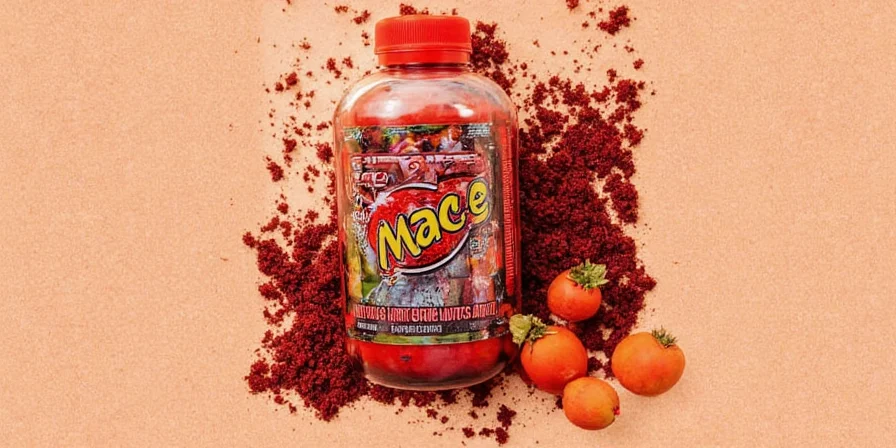Mace is the crimson aril (outer covering) surrounding the nutmeg seed from the Myristica fragrans tree. Unlike its more famous counterpart nutmeg, mace delivers a brighter, more complex flavor profile with citrus and floral notes. This comprehensive guide answers your most pressing questions about mace versus nutmeg, proper usage, and science-backed culinary applications.
Key Mace Facts at a Glance
- What it is: The dried outer membrane of the nutmeg seed
- Flavor profile: Citrusy, floral, and warm (less intense than nutmeg)
- Best for: Delicate sauces, custards, light proteins, and baking
- Substitution: Use 1.3g mace for every 1g nutmeg by weight
- Storage: Whole blades in amber glass (grind before use)
What Exactly is Mace? Understanding the Basics

Mace is the delicate crimson membrane that surrounds the nutmeg seed within the Myristica fragrans fruit. When harvested, this membrane is carefully separated from the seed, then sun-dried until it transforms into golden-orange "blades" of mace. This structural difference creates fundamentally distinct flavor characteristics compared to nutmeg.
Mace vs Nutmeg: Critical Differences You Need to Know

| Characteristic | Mace | Nutmeg |
|---|---|---|
| Chemical Composition | Higher eugenol (clove-like), lower myristicin | Higher myristicin, dominant terpenes |
| Flavor Profile | Brighter, more floral with citrus notes | Warmer, woodier, more intense |
| Best Culinary Uses | Delicate sauces, custards, light proteins | Stews, braises, robust baked goods |
| Thermal Tolerance | Add late (max 140°C) | Withstands prolonged heat (up to 180°C) |
| Color Impact | Imparts golden hue | Minimal color contribution |
Understanding these differences is essential for proper spice selection. Mace's higher solubility in dairy makes it ideal for creamy sauces where you want flavor integration without overpowering other ingredients.
5 Practical Kitchen Applications for Mace

- For Creamy Sauces: Add 0.1g ground mace during the roux stage to prevent curdling while enhancing flavor integration
- In Custards: Steep whole blades in warm dairy (65°C) for optimal flavor extraction without bitterness
- For Tomato-Based Sauces: Use to counteract acidity without adding sweetness
- In Fruit Preserves: Combine with pectin to improve gel structure without overpowering fruit flavors
- For Seared Proteins: Dust on proteins before searing to accelerate browning
Proven Storage and Substitution Techniques

- Precise Substitution: Replace nutmeg with 1.3x mace by weight for equivalent flavor (not volume)
- Storage Protocol: Keep whole blades in amber glass containers; light degrades quality within 30 days
- Freshness Tip: Grind immediately before use; pre-ground loses 60% volatile oils within 48 hours
- Reviving Old Mace: Reconstitute dried blades in warm liquid (1:5 ratio) for 20 minutes
Evidence-Based Benefits and Safety

Research confirms these culinary-relevant properties:
- Antimicrobial: Effective against foodborne pathogens at normal cooking concentrations
- Digestive Aid: Stimulates gastric enzymes at 0.5g doses
- Antioxidant: ORAC value of 105,000 μmol TE/100g surpasses most spices
Common Questions Answered
Is mace the same as nutmeg?
No. Mace is the outer membrane surrounding the nutmeg seed. They come from the same fruit but have different flavor profiles and culinary uses. Mace has brighter, more citrusy notes while nutmeg is warmer and more intense.
Can I substitute mace for nutmeg in recipes?
Yes, but use 1.3 grams of mace for every 1 gram of nutmeg by weight. Volume measurements are inaccurate due to density differences. For cold preparations, increase mace by 20% since solubility decreases at lower temperatures.
Why is my mace losing flavor so quickly?
Mace contains 15% volatile oils (vs nutmeg's 8%) and has larger surface area, accelerating oxidation. Store whole blades in amber glass containers away from light and air. Always grind mace immediately before use for maximum flavor impact.
How to Use Mace in Everyday Cooking
For home cooks, mace shines in these practical applications:
- Add a single blade to poaching liquid for pears or apples
- Include in béchamel sauce for enhanced flavor in lasagna
- Mix into cookie dough for subtle complexity
- Infuse in cream for custards and ice cream
- Combine with allspice in Caribbean-style jerk seasoning
Remember that mace works best when added later in the cooking process to preserve its delicate flavor compounds. Start with small amounts (1/8 teaspoon ground mace per serving) and adjust to taste.











 浙公网安备
33010002000092号
浙公网安备
33010002000092号 浙B2-20120091-4
浙B2-20120091-4